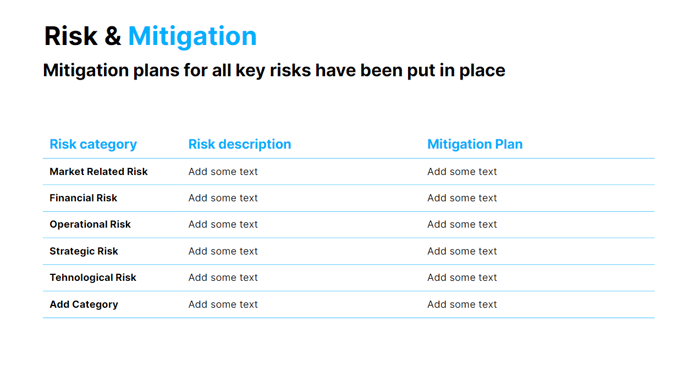In this section, identify and outline the key risks and challenges that your business may face and how you can mitigate those⚔️
These can include market risks, operational risks, financial risks, regulatory risks, or any other significant risks specific to your industry 🧩
(1) Assess impact and likelihood
Evaluate the potential impact and likelihood of each identified risk. Explain how these risks could affect your business operations, financial performance, or overall success. Use data or examples to provide context and demonstrate the seriousness of these risks.
(2) Discuss mitigation strategies
Present the strategies and measures you have in place to mitigate the identified risks. Describe the specific actions you are taking to minimize the impact or likelihood of each risk. This can include contingency plans, insurance coverage, partnerships, or internal controls.
(3) Highlight risk management team (if applicable)
Introduce the members of your risk management team or any individuals responsible for overseeing risk mitigation efforts. Highlight their expertise and experience in managing risks, which instills confidence in your ability to navigate challenges effectively.
(4) Address scalability and adaptability (if applicable)
Discuss how your risk mitigation strategies are designed to scale alongside your business growth and adapt to changing circumstances. Explain how you continuously evaluate and update your risk management approaches to stay proactive and resilient.
(5) Provide contingency plans (if applicable)
Share any contingency plans you have developed to address potential worst-case scenarios. Explain how these plans would be activated in the event that certain risks materialize, ensuring that investors have confidence in your preparedness.
(6) Communicate risk-aware culture (if applicable)
Emphasize your commitment to maintaining a risk-aware culture within your organization. Discuss how risk management is integrated into your decision-making processes, and how all team members contribute to identifying and addressing risks.
If applicable, (depending on your industry exposure to risk e.g., banking, chemical industry) highlight your risk management team and contingency plans ✔️
Communicate your commitment to a risk-aware culture and adaptability.
Here are some common risk types 👇
- Market Risk: Changes in market demand, competition, or industry trends that could impact your business's ability to attract customers or generate revenue.
- Financial Risk: Fluctuations in cash flow, profitability, or access to capital that could affect your business's financial stability and ability to meet financial obligations.
- Operational Risk: Issues related to day-to-day operations, such as supply chain disruptions, equipment failure, or operational inefficiencies that may impact productivity and profitability.
- Regulatory and Compliance Risk: Non-compliance with applicable laws, regulations, or industry standards that could result in penalties, legal action, or reputational damage.
- Technological Risk: Dependence on outdated or unreliable technology, data breaches, or cybersecurity threats that could compromise sensitive information or disrupt business operations.
- Human Resources Risk: Challenges related to talent acquisition, employee retention, skills gaps, or labor disputes that could impact team performance and productivity.
- Legal Risk: Potential legal disputes, lawsuits, or intellectual property infringement claims that could result in financial losses, reputational damage, or legal consequences.
- Reputational Risk: Negative public perception, customer dissatisfaction, or damage to your brand's reputation that could affect customer trust, loyalty, and future business opportunities.
- Environmental and Sustainability Risk: Risks associated with environmental impact, sustainability practices, or compliance with environmental regulations that could have legal, reputational, or operational implications.
- Strategic Risk: Poor strategic decision-making, ineffective business planning, or failure to adapt to market changes that may hinder growth, competitive positioning, or long-term success.

-2.png?height=120&name=Modeliks%20Logo%20(blue%20modeliks%20right)-2.png)